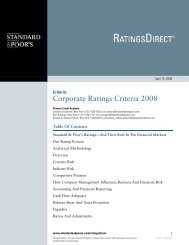European Infrastructure Finance Yearbook - Investing In Bonds ...
European Infrastructure Finance Yearbook - Investing In Bonds ...
European Infrastructure Finance Yearbook - Investing In Bonds ...
Create successful ePaper yourself
Turn your PDF publications into a flip-book with our unique Google optimized e-Paper software.
UTILITIES<br />
Publication Date:<br />
Aug. 17, 2007<br />
Issuer Credit Rating:<br />
A+/Negative/A-1<br />
Primary Credit Analyst:<br />
Peter Kernan,<br />
London,<br />
(44) 20-7176-3618<br />
Secondary Credit Analysts:<br />
Amrit Gescher,<br />
London,<br />
(44) 20-7176-3733<br />
Ralf Etzelmueller,<br />
Frankfurt,<br />
(49) 69-33-999-123<br />
46 ■ NOVEMBER 2007<br />
RWE AG<br />
Rationale<br />
The ratings on Germany-based utility RWE AG<br />
reflect the group’s strong competitive position in<br />
the German electricity market, which provides the<br />
majority of group earnings and has delivered<br />
sustained strong operating performance. The<br />
ratings also reflect the group’s strong financial<br />
profile. These strengths are partially offset by the<br />
weakening of RWE’s business profile following<br />
the sale of its regulated water operations and its<br />
reliance on competitively exposed generation for<br />
future growth.<br />
Competition in the German retail market<br />
remains moderate. Nevertheless, the introduction<br />
of a network regulator and tariff cuts will likely<br />
increase competitive pressures. Meanwhile, RWE’s<br />
substantially lower level of freely granted carbon<br />
dioxide (CO2) allowances for phase 2 of the EU<br />
Emissions Trading Scheme (2008-2012) will likely<br />
reduce generation margins. (RWE estimates that<br />
slightly more than 50% of its German CO2<br />
emissions will be covered by free allowances.)<br />
RWE will, however, benefit from changes in the<br />
German tax regime, which will result in the<br />
average tax rate on German profits dropping to<br />
31% from about 39%, from 2008.<br />
RWE’s balance sheet has further strengthened<br />
following the sale of RWE Thames Water for an<br />
enterprise value of £8.0 billion (sale price of £4.8<br />
billion plus pro forma net debt of £3.2 billion) in<br />
December 2006. At June 30, 2007, net debt<br />
(including pension provisions, and under RWE’s<br />
definition) was €6.8 billion. RWE plans to<br />
complete the sale of its U.S. water business<br />
through an IPO by the end of 2007, subject to<br />
market conditions, which will further deleverage<br />
the group. RWE has a general net debt cap of<br />
between €22 billion and €24 billion and has<br />
substantial headroom relative to this cap to<br />
increase leverage. RWE has material nuclear asset<br />
retirement obligations, of which Standard &<br />
Poor’s Ratings Services treats about €7 billion<br />
as debt.<br />
The group’s financial performance has been<br />
strong over the past few years, with funds from<br />
operations (FFO) increasing to more than €7<br />
billion for full-year 2006, on the back of strong<br />
power prices. The medium-term outlook for<br />
power prices continues to be favorable on the<br />
back of tight capacity margins and tightness in<br />
fuel markets--given strong global demand for<br />
commodities--as well as a tighter market for CO2.<br />
STANDARD & POOR’S EUROPEAN INFRASTRUCTURE FINANCE YEARBOOK<br />
RWE’s target for 2007 is that revenue will rise<br />
slightly above the 2006 level of €44.2 billion and<br />
that EBITDA will rise by between 5% and 10%<br />
above the 2006 level of €7.17 billion.<br />
There is an ongoing debate within the EU about<br />
levels of competition in power markets, and a<br />
draft third liberalization directive is expected later<br />
in 2007. Among other areas, the debate has<br />
focused on ownership unbundling of transmission<br />
businesses to increase competition. Such a<br />
measure could adversely affect RWE’s German<br />
business, but Standard & Poor’s currently<br />
considers that it is unlikely that this change will<br />
be required.<br />
Short-term credit factors<br />
The ‘A-1’ short-term rating is underpinned by<br />
large and diversified cash flows (cash flows from<br />
operating activities were in excess of €2.5 billion<br />
for the six months to June 30, 2007), RWE’s<br />
current low level of net debt, and a benign<br />
maturity profile. The rating is also supported by<br />
substantial alternative sources of liquidity,<br />
including more than €12 billion of liquid<br />
securities held to offset on-balance-sheet nuclear<br />
liabilities. At Dec. 31, 2006, €5.5 billion of<br />
RWE’s €20.0 billion debt issuance program was<br />
available. RWE faces a moderate maturity peak of<br />
about €3.7 billion in 2007. <strong>In</strong> addition, the<br />
company had unused funds of €3.5 billion<br />
equivalent under its $5.0 billion CP program at<br />
Dec. 31, 2006.<br />
Outlook<br />
RWE’s financial profile is strong for the ratings.<br />
The negative outlook, however, reflects some<br />
near-term uncertainty about the direction of<br />
RWE’s strategy, financial and acquisitions<br />
policies--in part due to planned changes in senior<br />
management--and the manner in which RWE<br />
could releverage its balance sheet.<br />
The deterioration of RWE’s business profile as a<br />
result of the water disposals could negatively<br />
affect the ratings if the disposals are followed by<br />
rapid and substantial investments in riskier<br />
operations. To maintain the ratings, RWE needs<br />
to restrict itself to moderate-scale or low-risk<br />
acquisitions, and maintain conservative financial<br />
policies. The outlook could be revised to stable<br />
if RWE maintains its current strong<br />
financial profile. ■



